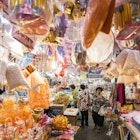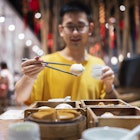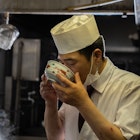
Tokyo restaurant etiquette: the ultimate guide to dining in Japan’s capital



Simple chopstick etiquette and some general know-how are all you need to dig into Tokyo's dining scene ? Kiattipong / Shutterstock
Want to take a deep dive into Tokyo’s famous (and famously amazing) dining scene, but worried about committing some unforgivable gaffe? Here's all you need to know to eat like a local. Hint: it’s not as hard as you might have feared. In fact, once you nail the logic of eating in Tokyo, it all makes a lot of sense.

1. Tokyo restaurants are small
Really small. This is the most important thing you need to know about dining out in the city. A restaurant might literally have only 12 stools at the counter, and maybe two tables that can each seat up to four.
And this set-up is not at all unusual. Many Tokyo dining etiquette conventions stem from the specific requirements of keeping such small enterprises afloat. The dining scene is also highly competitive. For that reason, most restaurants are run on extremely tight margins.

2. Restaurants are terrified of no shows
If you have in mind the image of a chef-run restaurant with seating for 20, you can imagine the impact that a party of four skipping out on their reservation would have on the restaurant's haul for the night.
Especially if the chef made a special trip to the market that morning just to buy ingredients for your meal.
Unfortunately, there is a widespread belief among Tokyo restaurants that overseas guests are more likely to flake on reservations than local diners.
There may be some truth to this: after all, it can be stressful to ring up a restaurant where no English is spoken (and out-of-towners don't have to worry about never being able to show their faces there again).
More likely it’s a case of a few examples blown out of proportion. But every no-show amplifies the echo chamber and makes it harder for overseas visitors to get reservations.
There are now a handful of restaurants that will only accept reservations from foreign travelers through the intermediary of a hotel concierge; others require you to give a local phone number.
Third-party reservation websites and apps, such as and , however, are somewhat filling the gap, making it easier for non-Japanese speaking diners to arrange (and cancel) reservations on their own at participating establishments.
Whatever the case may be, if you just can’t make it, please find a way to communicate that to the restaurant, ideally the day before (your accommodation can usually help with this). Note that no-shows are sometimes expected to pay a cancellation fee, which may be as much as the cost of a whole meal.

3. Do I even need to make a reservation?
Good question! The short answer: generally, no. Many casual places don't even take reservations, with popular spots enjoying the free advertising that a long line out front creates.
For these places, your strategy should be to show up outside of peak meal times, which is roughly 11:30am to 1pm and 6pm to 7:30pm, but not in the middle of the afternoon (when restaurants are often closed).
Now the exceptions: for any restaurant that counts as a destination in and of itself, at which you have your heart set on eating, absolutely make a reservation (if the restaurant takes them).
High-end places expect you to make a reservation, though they will graciously accept walk-ins if they have the space and ingredients. This is also an opportunity to discuss any dietary restrictions (high-end places are the most flexible with regards to this).
Tokyoites tend to make reservations for pretty much any planned meet-up at any restaurant that falls in or above the broad mid-range category.
That doesn't mean you have to, though it may mean you don’t get a table at your top choice. Friday and Saturday nights are the busiest, but Tokyoites are out all nights of the week.
It really comes down to which you prefer: being locked into a fixed dining schedule but getting to eat where you want, or having to work it all out on the fly. If you’re flexible and up for spontaneous decisions, going reservation-free is totally fine – as long as you’re not a large group.

4. Party size matters
It is usually easy for a restaurant to find seating for two, trickier for a group of four (you’ll have to wait until a table opens up) and significantly more challenging for groups larger than four. In fact, some restaurants require parties of five or more to call ahead.
At quick and casual joints, like noodle counters, consider breaking your group into pairs to move things along faster (which will make the restaurant happier).
The good news for solo travelers is that Tokyo is a city that embraces the lone diner, where everyone at the counter will squish together to make room for you. Servers may even offer you a coveted table, if one is available, so that you can eat and read your book in peace with dignity – just don’t stay too long.
5. Consider the menu
If you're used to requesting changes to menu items beyond standard options already set out by the restaurant, you should note that Japan does not have a culture of menu modifications.
In fact, staff and other diners may be wondering why you are ordering a dish you don't want to or can't eat in the first place.
Depending on the kitchen set-up, the restaurant may not be able to accommodate such changes even if they wanted to.
Japan can be a challenging destination if you have allergies or other special dietary requirements that prevent flexibility on this, so it's worth spending the time to research restaurants in advance to scout out suitable dishes or eateries that are accustomed to catering to specific dietary needs.
If making a reservation, it's best to communicate dietary requirements at this time to avoid disappointment.
Awareness of diverse food needs is increasing, however, and some no-reservation casual and fast-food eateries have even introduced "allergen free" menu items that don't include some of the major allergens and are stored separately in sealed packaging, making it easier to find something safe to eat in a pinch.
Carrying an allergen card in Japanese (variations of which can be found online) that outlines what you can and can't eat will make the process a lot smoother.
6. Familiarize yourself with "the form"
Some restaurants have a clipboard with a list at the entrance, which incoming diners are expected to fill out.
This is often misinterpreted by foreign travelers that a reservation is required, but is simply so staff know the order of arrival and how many people in each party, and therefore tables can be organized accordingly.
You should complete this form even if no one else appears to be waiting, unless staff direct you otherwise.
Typically, the form asks for a name (名前) and number of diners (look for the character 人). Depending on the type of establishment, it may also ask you to circle the kind of seating (席) you would like, such as table (テーブル) or counter (カウンター), and there's usually an option if either is fine (どちらでも), in which case you'll get the one that becomes available fastest.
Specifying smoking (喫煙席) or non-smoking (禁煙席) seating may also be an option, although this is far less frequent now that Tokyo has more smoke-free venues than smoking ones thanks to a 2020 ordinance put in place ahead of the Olympics.
If possible, writing your name in katakana (a Japanese script with comparatively simple straight lines and curves used for words of foreign origin) will help put your host at ease as it will tell them how to pronounce it. That said, writing in Roman alphabet (谤ō尘补箩颈) is perfectly acceptable.
In restaurants with this system, there is often a small area with seats for waiting diners, but expect to be standing at busier times. Tokyo's quick turnover usually means the queue moves more quickly than you'd think, so don't be put off dining somewhere simply because there are a number of names ahead of you.
Sometimes staff will offer menus and even take your order before being seated to reduce waiting times.
That being said, if you decide it's really taking too long and you haven't ordered yet, politely return to the form and put a line through your name (and the entire row you wrote on), to alert staff that you no longer require a table.
7. Be mindful of the time
Second to no-shows, restaurants’ biggest concern is adequate turnover. This is especially true at lunch.
It’s no secret that lunch is Tokyo’s great bargain, but restaurants can only offer such great prices because they anticipate a high turnover. And Tokyo is not a city with a long lunch break culture.
Restaurants get grumpy if you hold onto a table too long, sipping tea without ordering anything more. Lingering at noodle counters is also a big no-no. Tokyoites know that if they want to carry on chatting they should move on to a nearby cafe.
And, yes, Tokyo’s thousand-odd cafes seem to defy all logic (we don't understand how they stay in business either).

8. Read the room
The truth is, restaurants aren’t as fussed by the normal tourist gaffes as you might think. Sure, the chef might secretly die a little inside if you pour soy sauce over an already-seasoned dish – the same way chefs in other parts of the world might do if you salt your food before you taste it.
There are only two things you can do that are likely to freak people out, and that is to stick your chopsticks upright in a bowl of rice or to pass food from one pair of chopsticks to another. Both are similar to Buddhist funeral rites.
Tokyo does have a handful of famously fastidious chefs but they are most definitely a minority. Far more would rather you enjoyed the food than worry about the proper order in which to eat it.
Pro tip: a compliment, like 'oishii desu!' ('this is delicious!') can make up for pretty much anything.

Really, to avoid embarrassment, you just need to do what the Japanese do: read the room. Each restaurant has its own culture set by its owner and the regular customers it attracts.
At some you have to scream to be heard over the din; others are hushed, sober affairs. Any Tokyoite who enters a restaurant for the first time would do a quick mental sweep of the place and adjust accordingly.
9. Don’t knock the chains
If all of the above sounds like a giant hassle, know that many locals share that opinion. That's why there are plenty of chain restaurants staffed by part-timers who aren't bothered if you don't show up, order too little, overstay or leave puddles of soy sauce all over the table.
Chain restaurants are usually big and can more easily accommodate larger groups. They're also more likely to have English menus, children’s meals, allergens listed as standard, and distinct smoking and non-smoking areas (or be completely smoke-free). They're cheap and usually pretty good.
Some chains, particularly those known as "family restaurants", offer a 'drink bar' (ドリンクバー) option for just a few hundred yen.
The drink bar gives you unlimited refills from a self-serve drink station (usually with a range of juices, soft drinks, tea and coffee from a machine) and is convenient for when you want some extra time to relax without the pressure of up and leaving right away.
Explore related stories

Food and Drink
6 of the best places for sushi in Kanazawa, Japan’s sushi capitalOct 28, 2024 ? 5 min read


 Food10 of the world’s best foodie destinations (and what to eat when you get there)
Food10 of the world’s best foodie destinations (and what to eat when you get there)Mar 1, 2024 ? 12 min read

 Art and CultureThese attractions in Tokyo and Osaka will awaken your five senses
Art and CultureThese attractions in Tokyo and Osaka will awaken your five sensesSep 29, 2021 ? 8 min read


 FoodRiding Japan’s ‘New Golden Route’: The vibrant cities of Tokyo, Kyoto and Osaka
FoodRiding Japan’s ‘New Golden Route’: The vibrant cities of Tokyo, Kyoto and OsakaFeb 17, 2021 ? 8 min read

